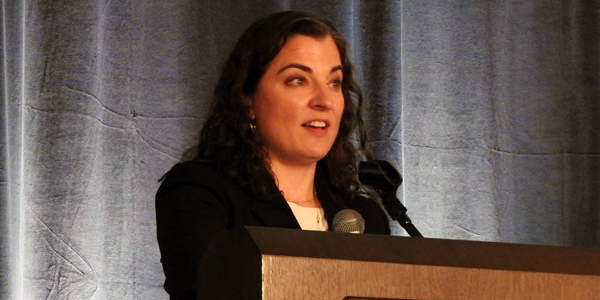By Rory D. Sweeney
HERSHEY, Pa. — The prevalence of gas-fired generation has skyrocketed in recent years, upending power market structures and leading to nationwide debate over the future of the electricity industry.

Simeone | © RTO Insider
Much of that might be attributable to what Christina Simeone, director of policy and external affairs for the University of Pennsylvania’s Kleinman Center for Energy Policy, calls the “Pennsylvania Gas Discount.”
At a conference to analyze Pennsylvania’s electricity markets last week, Simeone unveiled her study on price impacts from the recent expansion in shale gas development.
“The electric power sector is now the natural gas industry’s No. 1 customer both in Pennsylvania and nationally,” she said.
That has come, she said, because production from the state’s Marcellus shale has been prodigious, while “takeaway capacity has not kept up with production growth.” In 2007, Pennsylvania accounted for less than 1% of the nation’s natural gas production and consumed four times more gas than it produced. By 2016, the state had increased its output 2,800%, accounting for 16% of national production — four times more than it consumed.
In-state pipeline construction has not maintained that pace. Simeone said FERC has approved 59 interstate pipeline projects since 2007 that would impact Pennsylvania, but many of them have been delayed. Williams’ Constitution pipeline, for example, was approved in 2014, but construction has been blocked by a permitting battle with New York.
The pipeline constraints have led to an oversupply that has dramatically depressed in-state prices.
“The electric power sector is really where prices dropped the most,” she said.
Average annual delivered power prices in Pennsylvania in 1997 were $3.02/Mcf, 24 cents more than the national average of $2.78. The differential widened to 70 cents in 2007, with Pennsylvania prices rising to $8.01/Mcf.
By 2016, the Pennsylvania average had fallen $1.05 below the national average to $1.95/Mcf.
Correspondingly, in-state consumption since 2007 increased by half, with usage up almost 250% by Pennsylvania gas-fired generators, whose number increased 15% in that time. Gas deliveries for power production nationwide have risen 46% in the past decade, as gas-fired units increased nearly 4%.
The price drop has had a profound impact on power markets, shaking the fundamentals of market design and sparking a national debate about subsidies for financially struggling coal and nuclear generation. (See RTOs Reject NOPR; Say Fuel Risks Exaggerated.)
Simeone said it’s unclear how long the discount will continue because there are “huge reserves, but we also have this record interest in pipeline takeaway capacity.” If built, the nearly 60 FERC-approved projects could transport more than 20 Bcfd, but producers could also increase supply, prolonging the Pennsylvania discount. Pennsylvania produced about 5,264 Bcf in 2016, according to Simeone’s research, and has a cumulative outflow of 6 Bcfd.


